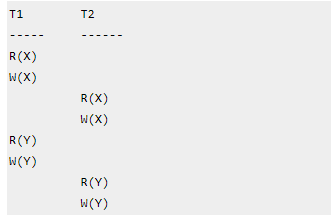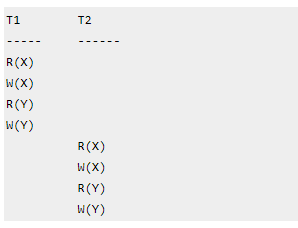DBMS View Serializability
View Serializability is a process to find out that a given schedule is view serializable or not.
To check whether a given schedule is view serializable, we need to check whether the given schedule is View Equivalent to its serial schedule. Lets take an example to understand what I mean by that.
Given Schedule:

Serial Schedule of the above given schedule:
As we know that in Serial schedule a transaction only starts when the current running transaction is finished. So the serial schedule of the above given schedule would look like this:

Why we need View Serializability?
We know that a serial schedule never leaves the database in inconsistent state because there are no concurrent transactions execution. However a non-serial schedule can leave the database in inconsistent state because there are multiple transactions running concurrently. By checking that a given non-serial schedule is view serializable, we make sure that it is a consistent schedule.
You may be wondering instead of checking that a non-serial schedule is serializable or not, can't we have serial schedule all the time? The answer is no, because concurrent execution of transactions fully utilize the system resources and are considerably faster compared to serial schedules.
View Equivalent
Lets learn how to check whether the two schedules are view equivalent.
Two schedules T1 and T2 are said to be view equivalent, if they satisfy all the following conditions:
1. Initial Read: Initial read of each data item in transactions must match in both schedules. For example, if transaction T1 reads a data item X before transaction T2 in schedule S1 then in schedule S2, T1 should read X before T2.
Read vs Initial Read: You may be confused by the term initial read. Here initial read means the first read operation on a data item, for example, a data item X can be read multiple times in a schedule but the first read operation on X is called the initial read. This will be more clear once we will get to the example in the next section of this same article.
2. Final Write: Final write operations on each data item must match in both the schedules. For example, a data item X is last written by Transaction T1 in schedule S1 then in S2, the last write operation on X should be performed by the transaction T1.
3. Update Read: If in schedule S1, the transaction T1 is reading a data item updated by T2 then in schedule S2, T1 should read the value after the write operation of T2 on same data item. For example, In schedule S1, T1 performs a read operation on X after the write operation on X by T2 then in S2, T1 should read the X after T2 performs write on X.
View Serializable
If a schedule is view equivalent to its serial schedule then the given schedule is said to be View Serializable. Lets take an example.
View Serializable Example

Lets check the three conditions of view serializability:
Initial Read
In schedule S1, transaction T1 first reads the data item X. In S2 also transaction T1 first reads the data item X.
Lets check for Y. In schedule S1, transaction T1 first reads the data item Y. In S2 also the first read operation on Y is performed by T1.
We checked for both data items X & Y and the initial read condition is satisfied in S1 & S2.
Final Write
In schedule S1, the final write operation on X is done by transaction T2. In S2 also transaction T2 performs the final write on X.
Lets check for Y. In schedule S1, the final write operation on Y is done by transaction T2. In schedule S2, final write on Y is done by T2.
We checked for both data items X & Y and the final write condition is satisfied in S1 & S2.
Update Read
In S1, transaction T2 reads the value of X, written by T1. In S2, the same transaction T2 reads the X after it is written by T1.
In S1, transaction T2 reads the value of Y, written by T1. In S2, the same transaction T2 reads the value of Y after it is updated by T1.
The update read condition is also satisfied for both the schedules.
Result:
Since all the three conditions that checks whether the two schedules are view equivalent are satisfied in this example, which means S1 and S2 are view equivalent. Also, as we know that the schedule S2 is the serial schedule of S1, thus we can say that the schedule S1 is view serializable schedule.

Leave Comment